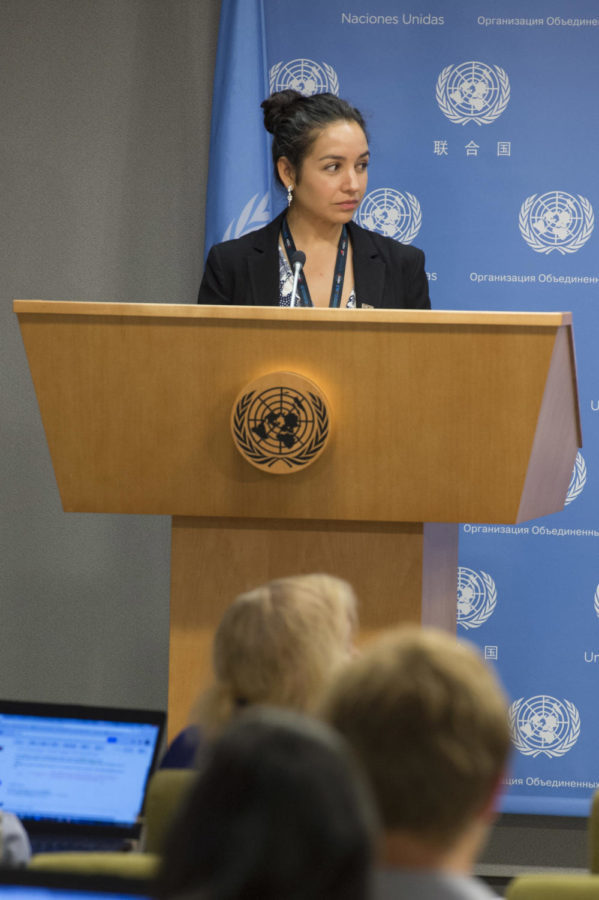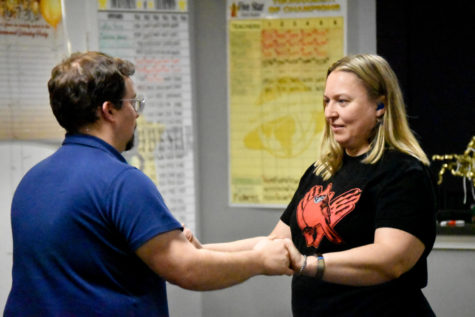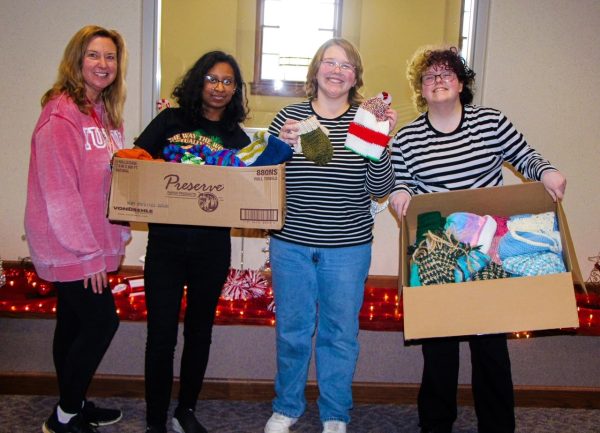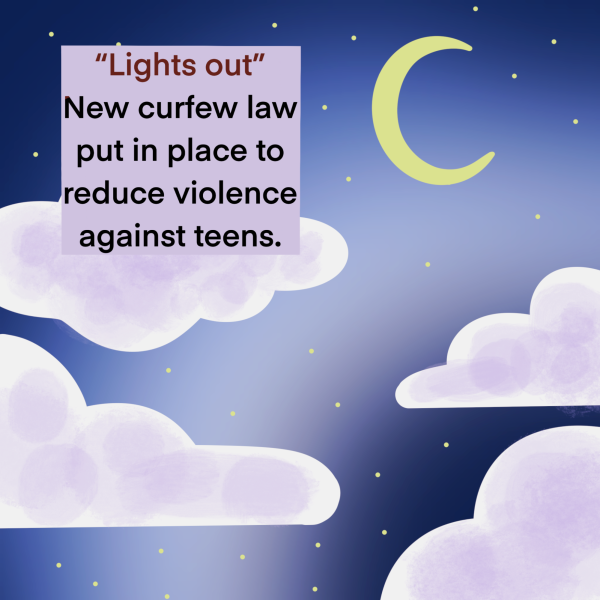‘Code red for humanity’
UN announcement leaves many with questions
Contributed by Florencia Soto Niño
Florencia Soto-Nino speaks at a UN press briefing. She spoke about a legally binding instrument meant to prohibit nuclear weapons.
Secretary General of the United Nations António Guterres labeled the climate status of the world as a “code red for humanity” back in August. The reasoning behind this was to grab the attention of those in power.
The code red announcement made many claims, including that some trends in climate change are already irreversible and that others will be soon. It also stated that the only way to stop these changes is to reach net zero carbon dioxide emissions.
This announcement has left many people feeling curious and concerned. But mostly, it has left people with questions unanswered.
What is causing this crisis? What does it mean for this generation, and what can people do about it?
What is causing this crisis?
Florencia Soto Niño, the associate spokesperson to Guterres, says that this crisis is ultimately caused by humans. There are several factors, however. Greenhouse gas emissions, pollution and food waste all affect the state of the planet.
“This is catastrophic,” Soto Niño said in an interview with The Journal. “The code red was really a wake up call, and it’s to everyone. That includes not just governments, but we’ve been very clear that everyone needs to be involved in the solution.”
This is catastrophic. The code red was really a wake up call, and it’s to everyone.
— Florencia Soto Niño
Greenhouse gases are one of the biggest causes of climate change. This is because the gases trap heat instead of letting it escape through the atmosphere. These gases also contribute to pollution.
“When you go places and see how people are living with the consequences, you’ll see it’s threatening their livelihoods,” Soto Niño said. “It’s global problem, global solution.”
Pollution is another major cause of climate change. Everyone has seen pollution whether they’re aware of it or not. Dark smoke coming out of a vehicle’s exhaust and factory smoke are examples of air pollution.
This pollution harms plants and crops because the ground level gases make plants susceptible to diseases and lowers their lifespan. Trees are a major producer of oxygen. They also absorb carbon dioxide, a greenhouse gas harmful to both humans and the environment. Fewer trees means more carbon dioxide.
Food waste might be one of the biggest problems when it comes to climate change. One third of all the food in the world that’s produced is either lost or thrown away. When this food gets sent to a landfill and begins to decompose, it creates methane–a toxic gas even more potent than carbon dioxide.
What does it mean for this generation?
All this information comes down to this: if people stay on the same track they’re on now, it could mean disastrous things for the fate of the planet. Increase in temperature, more harmful gases staying in the atmosphere and biodiversity being affected will all happen.
The planet is not doomed for extinction, at least not yet. If changes are made now, there’s a chance the world can return to its natural state. However, studies show that in 2030 there will be irreversible effects if those changes don’t happen soon.
“We’re at the point where it can go one way or another,” Soto Niño said.
What needs to happen is a reconfiguration of the economy. While it’s an extreme task and will take a lot of work, it’s necessary if there’s any hope of saving the planet.
While, yes, it’s going to take a lot to change how things are being operated, it’s a team effort.
“We know what we have to do,” environmental science teacher Rachel Brunsell said. “We just have to do it and put environmentalism over capitalism.”
We know what we have to do. We just have to do it and put environmentalism over capitalism.
— Rachel Brunsell
Several major companies and corporations have histories of influencing climate change as well. For example, fossil fuel companies are using large amounts of energy and releasing nitrogen oxides into the atmosphere. Nitrogen oxides contribute to forming smog and acid rain.
This issue is going to take more than change from governments and leaders. While they are the ones that have the power to make a change quicker, it takes everyone.
For the current generation and those of the future, the crisis is in their hands. Babies being born now won’t even be teenagers before the deadline hits.
All of the environmental problems in the world including pollution, greenhouse gases and failing crops are going to be worse if changes aren’t made now.
“Anything that’s in existence now is going to be more extreme,” Brunsell said. “Crops are going to be heavily affected, so that’s going to be a problem.”
What can people do about it?
In schools, there are many things that could be done. For example, paper usage could be cut down. During the last school year when SHS was doing virtual learning, it became normal to do all work online. Just because teachers have access to paper worksheets again doesn’t mean they have to use them.
“Less paper could be used,” Junior Ben Henderson said. “A lot of teachers went back to paper because they said they missed it when they could keep stuff online and save paper.”
A recent study shows that another solution is reusable silverware. This is an alternative to the disposable plasticware being used daily in many schools.
The study, which was done in two middle schools in Minnesota, showed the effectiveness of this simple change. The schools replaced their plastic silverware and styrofoam bowls with reusable options. In the span of just one year, they prevented 6,000 pounds of waste from being created, reduced their emission of greenhouse gases by 77% compared to when they used plastic utensils and saved about $3,000 between both schools.
While it may seem like big corporations are the only ones who can effect change, experts say it is important for everyone to do their part.
Students, experts say, can pay more attention. They can start small; recycle, reduce meat consumption and spread awareness. One of the fastest ways to get more people involved is to make them aware.
Students and teachers think that there are things that SHS could change to do its part.
Henderson suggests the use of hand dryers in restrooms rather than the paper towel dispensers the school uses now.
Brunsell says that SHS would benefit from composting food scraps.
“If we compost all that can be composted, the stuff going into the trash would be much, much less,” Brunsell said.
All of these solutions can come together and help the planet. The 2030 deadline is quickly approaching, Soto Niño says, and change has to happen now. There is no other option.
“We all share one planet and we can decide how we want to keep it,” Soto Niño said.

Wow. Hey guys! For the third and final time on staff, my name is Gretchen. It’s almost crazy to think about it being my last year because yesterday I...










